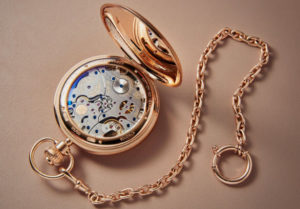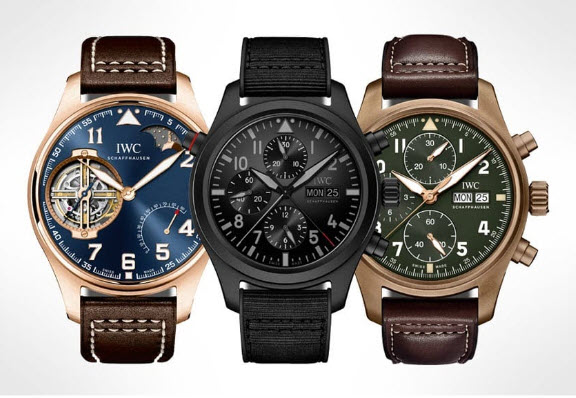
IWC, also known as International Watch Company, is a luxury Swiss watch manufacturer. Founded in 1868 by an American watchmaking pioneer called Florentine Ariosto Jones (1841-1916), IWC was opened as the first and only watch manufacturer in the north-eastern part of Switzerland. Jones, 27 years old then was a deputy director and manager of E. Howard Watch and Clock Company in Boston, a leading American watchmaker at the time.
He had an aim to produce high-quality pocket watches for the American market by combining advanced American manufacturing technologies together with precise craftsmanship by the Swiss, creating a modern factory where production will take place at a centralised place. However, many skilled workers in the region were not on board with Jones’ idea as they were not ready to move their industry into the modern 19th century. Thereafter, Jones was introduced to Heinrich Moser, a watch manufacturer and industrialist in Schaffhausen. He built the first hydroelectric plant and laid the cornerstone for future industrialisation in Schaffhausen. It was the center of one of the oldest clocks-making areas on the Rhine, and it is across the river from Germany. It is Jones’ plan to be able to produce high-quality watches in large batches in-house that are of the same tolerances to enable such timepieces to be famous around the world.

After seven years in 1975, Jones built a new factory that was along the banks of the River Rhine. In it, he had 196 employees serving in the company. Five years later in 1880, Jones sold IWC to Johannes Rauschenbach-Vogel (1815-1881), an industrial engine manufacturer in Schaffhausen. The company was renamed Uhrenfabrik von J. Rauschenbach. A year after the sale was completed, Johannes Rauschenbach passed on, leaving his son, Johannes Rauschenbach-Schenk to take over. The company was renamed Uhrenfabrik von J. Rauschenbachs Erben. Rauschenbach-Schenk took on the company when he was 25, and ran it until his passing in 1905.
Rauschenbach-Schenk left behind his wife and two daughters, with his sons-in-law to take over the business. Ernst Jakob Homberger, who was the director of G. Fischer AG decided to take the reins of the company in 1905, eventually becoming the sole proprietor of the company after buying out the shares of Carl Jung, his brother-in-law in 1929. The company was renamed to Uhrenfabrik von Ernst Homberger-Rauschenbach. There were two other significant people who made contributions to the company, one was Urs Haenggi. He joined IWC in 1883 and stayed with the company for 52 years. Another individual, Johann Vogel, was a technician who played an important role in the company as technical director until 1919. In 1944, Albert Pellaton took up his post as the Technical Director of IWC.

Hans Ernst Homberger, son of Ernst Jakob Homberger, joined the company in 1934 and took control of the company after his father’s death in 1955. In 1978, German instrument manufacturer VDO Adolf Schindling AG took over IWC as it needed a high level of venture capital for its change in direction and plans due to the quartz crisis in the 70s and 80s. IWC also acquired its name originally given by Jones. In total, the Rauschenbach family owned IWC for four generations under sole proprietorship. In 1981, Kawal Singh succeeded Homberger as general manager after he had retired. Günter Blümlein was appointed as the new director and played a major role in the company’s development and assisted the company in solidifying its finances. In 1991, Blümlein founded the LMH Group, a luxury goods holding company that had 100% stake in IWC. In 2000, IWC became a part of Richemont, a Zug-based luxury goods giant. Richemont agreed to have IWC managed by the same executives from the LMH Group. The new east Annexe of the company’s premises in Schaffhausen was inaugurated in 2005. In 2007, IWC opened its watch museum to the public, showcasing its rich history right at the place where cases and movement parts were once made. The west annexe of the building for watchmakers was completed in 2008.
IWC Watches have a rich history, spanning across more than 135 years of watchmaking expertise and experience. In 1885, the Pallweber system was introduced - the first watches with digital hours and minutes display. In 1887, The Magique was manufactured, a pocket watch in a cabriolet case with a 24-hour display that can be used either as a hunter or an open-face pocket watch. One of the first known wristwatches in the market, a 64-calibre ladies’ pocket watch movement in a case attached to a leather band by lugs was produced in 1899. There was also a 63-calibre movement used for additional watches.
In 1915, the company developed two new calibres, the 75 and 76 Calibre, without and with small seconds respectively. These were the first movements designed for wristwatches. In 1931, IWC produced elegant rectangular watches that contain the newly designed, tonneau-shaped 87 calibre. In 1936, IWC launched their first “Special Pilot’s Watch”, which features a rotating bezel with an arrowhead index that can be used to register take-off times, as well as an anti magnetic escapement fitted into it. In 1939, the Portuguese watch was born. Two importers from Portugal order a series of large wristwatches with high-precision pocket watch calibres. Then in 1940, due to the demand for a central seconds hand, IWC developed the Big Pilot’s Watch 52 T.S.C. In 1944, IWC released a new wristwatch for military use by the British Army. The letters W.W.W stand for “Watch, Wrist, Waterproof”, engraved at the back of the watch. The royal arrowhead insignia is used as a mark of ownership. In 1946, his first design, the 89-calibre movement, had a central seconds hand and was extremely accurate. In 1948, the Pilot’s Watch Mark 11 was presented with the 89-calibre. Its soft-iron inner case provides high protection against magnetic fields.
In 1950, the 85-calibre was produced. Designed by Pellaton, it features IWC’s first automatic winding mechanism. This is an innovative pawl-winding system that replaces the traditional reciprocal gearing and was a patented proprietary development by IWC then. The Ingenieur with automatic winding was launched in 1955. In 1959, the first automatic women’s movement was released, the 44 calibre. In 1967, IWC marked the beginning of a successful series of professional diver’s watchers with the Aquatimer. The watch was water-resistant to an extremely deep 20 bar. The company’s Yacht club automatic was also unveiled at the Basel Watch Show. In 1969, IWC developed the Beta 21 quartz movement, a wristwatch calibre with quartz control at a frequency of 8192 hertz. The Da Vinci is the first wristwatch to feature the movement, marking a watch-making revolution. In 1976, a new Ingenieur was produced, into the Ingenieur SL. In 1977, IWC introduced the element of adding complications with more features into their watches, including a series of complicated pocket watches, some of which are also skeletonized. The 9721 calibre was also unveiled, the first pocket watch with a calendar and moon phase display. In 1978, IWC collaborated with F.A Porsche to produce the first wristwatch with a built-in compass.
In 1980, the world’s first chronograph in a titanium case was produced by IWC, designed by F.A. Porsche. IWC gains their expertise in the machining of titanium through the exchange of ideas with Aérospatiale as well as other leading technology specialists. In 1982, the ultra-rugged Ocean 2000 diver’s watch was launched, made of titanium and is pressure-resistant to 200 bar. In 1985, The Da Vinci is the first chronograph to feature a perpetual calendar that is mechanically programmed for the next 500 years and it is set by turning the crown, and there is also a four-digit year display available. In 1986, IWC introduced the use of zirconium oxide, a scratch-resistant and virtually unbreakable ceramic as a new case material. In 1987, the first rectangular, water-resistant and automatic watch with a perpetual calendar was presented, named Novecento, which is Italian for “20th century”. The Grande Complication which is at wristwatch size presents many functions: a chronograph with a perpetual calendar, minute repeater and moon phase display. This was a product seven years in the making; completed in 1990.
To mark IWC’s 125th anniversary in 1993, a watch was unveiled and named II Destriero Scafusia, “The Warhorse of Schaffhausen”. It was then the world’s most complicated mechanical wristwatch that came in a limited edition stock of 125 pieces. It features several complications, including a Tourbillon, split-seconds, minute repeater and perpetual calendar. In 1995, The Da Vinci was presented as a split-second chronograph with a tenth hand, to commemorate the 10th birthday of the automatic Da Vinci Chronograph. The new GST sports watch line debuted in 1997. In 1998, designers launched the Pilot’s Watch UTC (Universal Time Coordinated) which features an hour hand that can be adjusted in one-hour steps, as well as a 24-hour display. The GST Deep One was released in 1999, a demonstration of IWC’s creativity to diver’s watches. It is the first watch with a mechanical depth gauge.
In 2000, designers developed the company’s own movement for large wristwatches, with the extra-large 5000 calibre which runs for seven days non-stop and features a power reserve display and Pellaton automatic winding system. In 2002, the Big Pilot Watch was presented at the Salon International de la Haute Horlogerie (SIHH) in Geneva. It has a 7-day movement, automatic winding, power reserve and date display, reviving the tradition of the Big Pilot’s Watch. The new Spitfire range of pilot’s watches was released in 2003. In 2005, new additions to the Portuguese and Da Vinci were presented, with the Ingenieur coming back in 3 versions after 50 years. In 2007, the tonneau-shaped Da Vinci line was released, with a completely new movement and the Da Vinci Perpetual Calendar Edition Kurt Klaus, named after the man who invented the calendar in commemoration of his golden jubilee with IWC. The Big Ingenieur and Spitfire Double Chronograph were also released that year.
In 2008, for its 140th anniversary, IWC launched an exclusive Vintage Collection to pay tribute to the legendary founders of its six watch families. IWC released a new generation of technically improved Aquatimer watches as well as the Da Vinci Perpetual Calendar Digital Date with digital displays for the date and month in large numbers in 2009. For the first time ever in 2010, the Portuguese Tourbillon Mystère Rétrograde combines the flying tourbillon with a retrograde date display. In 2011, IWC presented the most complex and exclusive mechanical wristwatch ever at the European Southern Observatory (ESO) in Chile. In 2012, the TOP GUN line was released. In 2013, IWC collaborated with the Mercedes AMG Petronas Formula One Team to come up with an overhauled Ingenieur collection. IWC celebrated the 75th birthday of the Portugieser watch family, with a newly designed 52000-calibre family.

Today, IWC has 6 main collections of watches, mainly the Pilot’s Watches, Portugieser, Portofino, Da Vinci, Ingenieur, and Aquatimer. They have a total of over 100 watches available for people to select from. There are also special collections that are released from time to time to commemorate events or collaborations with others. Located in 99 countries worldwide, IWC has plenty of retail shops as well as authorised retailers. In Singapore alone, there are 16 authorised retailers as well as 2 boutiques that provide services and products specific to IWC watches. The rich history that they possess proves them to be of a really high-quality luxury watch manufacturer.

































